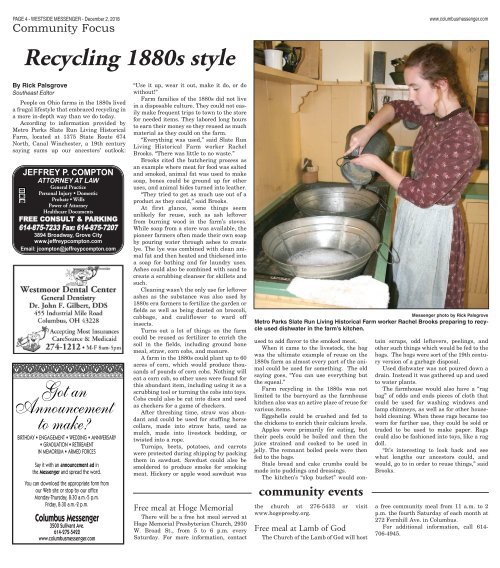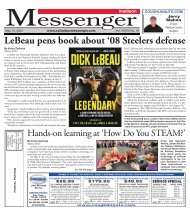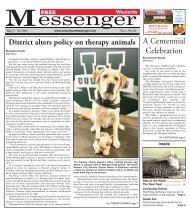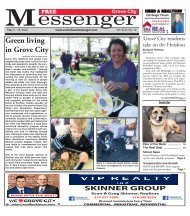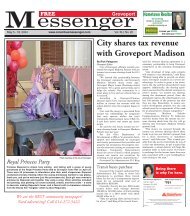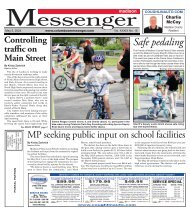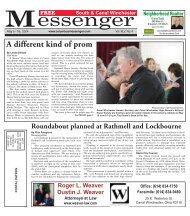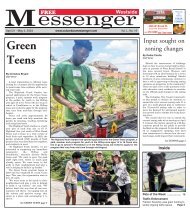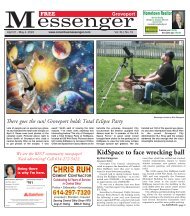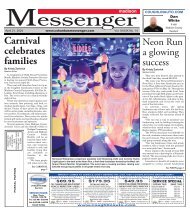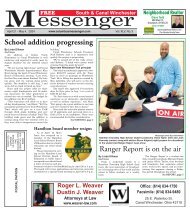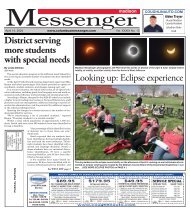Create successful ePaper yourself
Turn your PDF publications into a flip-book with our unique Google optimized e-Paper software.
PAGE 4 - WESTSIDE MESSENGER - <strong>December</strong> 2, <strong>2018</strong><br />
Community Focus<br />
www.columbusmessenger.com<br />
Recycling 1880s style<br />
By Rick Palsgrove<br />
Southeast Editor<br />
People on Ohio farms in the 1880s lived<br />
a frugal lifestyle that embraced recycling in<br />
a more in-depth way than we do today.<br />
According to information provided by<br />
Metro Parks Slate Run Living Historical<br />
Farm, located at 1375 State Route 674<br />
North, Canal Winchester, a 19th century<br />
saying sums up our ancestors’ outlook:<br />
JEFFREY P. COMPTON<br />
ATTORNEY AT LAW<br />
General Practice<br />
Personal Injury • Domestic<br />
Probate • Wills<br />
Power of Attorney<br />
Healthcare Documents<br />
FREE CONSULT & PARKING<br />
614-875-7233 Fax: 614-875-7207<br />
3894 Broadway, Grove City<br />
www.jeffreypcompton.com<br />
Email: jcompton@jeffreypcompton.com<br />
BIRTHDAY • ENGAGEMENT • WEDDING • ANNIVERSARY<br />
• GRADUATION • RETIREMENT<br />
IN MEMORIUM • ARMED FORCES<br />
Say it with an announcement ad in<br />
the <strong>Messenger</strong> and spread the word.<br />
You can download the appropriate form from<br />
our Web site or stop by our office<br />
Monday-Thursday, 8:30 a.m.-5 p.m.<br />
Friday, 8:30 a.m.-2 p.m.<br />
Columbus <strong>Messenger</strong><br />
3500 Sullivant Ave.<br />
614-272-5422<br />
www.columbusmessenger.com<br />
“Use it up, wear it out, make it do, or do<br />
without!”<br />
Farm families of the 1880s did not live<br />
in a disposable culture. They could not easily<br />
make frequent trips to town to the store<br />
for needed items. They labored long hours<br />
to earn their money so they reused as much<br />
material as they could on the farm.<br />
“Everything was used,” said Slate Run<br />
Living Historical Farm worker Rachel<br />
Brooks. “There was little to no waste.”<br />
Brooks cited the butchering process as<br />
an example where meat for food was salted<br />
and smoked, animal fat was used to make<br />
soap, bones could be ground up for other<br />
uses, and animal hides turned into leather.<br />
“They tried to get as much use out of a<br />
product as they could,” said Brooks.<br />
At first glance, some things seem<br />
unlikely for reuse, such as ash leftover<br />
from burning wood in the farm’s stoves.<br />
While soap from a store was available, the<br />
pioneer farmers often made their own soap<br />
by pouring water through ashes to create<br />
lye. The lye was combined with clean animal<br />
fat and then heated and thickened into<br />
a soap for bathing and for laundry uses.<br />
Ashes could also be combined with sand to<br />
create a scrubbing cleanser for skillets and<br />
such.<br />
Cleaning wasn’t the only use for leftover<br />
ashes as the substance was also used by<br />
1880s era farmers to fertilize the garden or<br />
fields as well as being dusted on broccoli,<br />
cabbage, and cauliflower to ward off<br />
insects.<br />
Turns out a lot of things on the farm<br />
could be reused as fertilizer to enrich the<br />
soil in the fields, including ground bone<br />
meal, straw, corn cobs, and manure.<br />
A farm in the 1880s could plant up to 60<br />
acres of corn, which would produce thousands<br />
of pounds of corn cobs. Nothing will<br />
eat a corn cob, so other uses were found for<br />
this abundant item, including using it as a<br />
scrubbing tool or turning the cobs into toys.<br />
Cobs could also be cut into discs and used<br />
as checkers for a game of checkers.<br />
After threshing time, straw was abundant<br />
and could be used for stuffing horse<br />
collars, made into straw hats, used as<br />
mulch, made into livestock bedding, or<br />
twisted into a rope.<br />
Turnips, beets, potatoes, and carrots<br />
were protected during shipping by packing<br />
them in sawdust. Sawdust could also be<br />
smoldered to produce smoke for smoking<br />
meat. Hickory or apple wood sawdust was<br />
Free meal at Hoge Memorial<br />
There will be a free hot meal served at<br />
Hoge Memorial Presbyterian Church, 2930<br />
W. Broad St., from 5 to 6 p.m. every<br />
Saturday. For more information, contact<br />
<strong>Messenger</strong> photo by Rick Palsgrove<br />
Metro Parks Slate Run Living Historical Farm worker Rachel Brooks preparing to recycle<br />
used dishwater in the farm’s kitchen.<br />
community events<br />
the church at 276-5433 or visit<br />
www.hogepresby.org.<br />
Free meal at Lamb of God<br />
The Church of the Lamb of God will host<br />
used to add flavor to the smoked meat.<br />
When it came to the livestock, the hog<br />
was the ultimate example of reuse on the<br />
1880s farm as almost every part of the animal<br />
could be used for something. The old<br />
saying goes, “You can use everything but<br />
the squeal.”<br />
Farm recycling in the 1880s was not<br />
limited to the barnyard as the farmhouse<br />
kitchen also was an active place of reuse for<br />
various items.<br />
Eggshells could be crushed and fed to<br />
the chickens to enrich their calcium levels.<br />
Apples were primarily for eating, but<br />
their peels could be boiled and then the<br />
juice strained and cooked to be used in<br />
jelly. The remnant boiled peels were then<br />
fed to the hogs.<br />
Stale bread and cake crumbs could be<br />
made into puddings and dressings.<br />
The kitchen’s “slop bucket” would contain<br />
scraps, odd leftovers, peelings, and<br />
other such things which would be fed to the<br />
hogs. The hogs were sort of the 19th century<br />
version of a garbage disposal.<br />
Used dishwater was not poured down a<br />
drain. Instead it was gathered up and used<br />
to water plants.<br />
The farmhouse would also have a “rag<br />
bag” of odds and ends pieces of cloth that<br />
could be used for washing windows and<br />
lamp chimneys, as well as for other household<br />
cleaning. When these rags became too<br />
worn for further use, they could be sold or<br />
traded to be used to make paper. Rags<br />
could also be fashioned into toys, like a rag<br />
doll.<br />
“It’s interesting to look back and see<br />
what lengths our ancestors could, and<br />
would, go to in order to reuse things,” said<br />
Brooks.<br />
a free community meal from 11 a.m. to 2<br />
p.m. the fourth Saturday of each month at<br />
272 Fernhill Ave. in Columbus.<br />
For additional information, call 614-<br />
706-4945.


